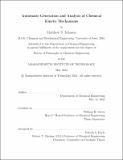Automatic Generation and Analysis of Chemical Kinetic Mechanisms
Author(s)
Johnson, Matthew S.
DownloadThesis PDF (11.92Mb)
Advisor
Green, William H.
Terms of use
Metadata
Show full item recordAbstract
Many important processes in the world are controlled by chemical kinetics, from the combustion of fuels in engines, the production of polymers, the electrochemistry of batteries to biological processes. However, many if not most overall chemical processes do not occur in a single step reaction between reactants and products and can involve hundreds of different elementary reactions and intermediates. In many cases how well we can resolve and parametrize these elementary reactions and intermediates control ability to predict the behavior of the associated process. These systems of species reactions and their associated parameters are usually referred to as detailed kinetic mechanisms. Creating detailed kinetic mechanisms, however, requires us to determine both what reactions can happen in a given system and how fast they occur. This can be incredibly tedious an challenging to do by hand so it is often more practical to use automatic mechanism generators such as the Reaction Mechanism Generator (RMG) software. RMG allows us to build a workflow for generating and refining these mechanisms where we run RMG to generate a mechanism analyze the mechanism to determine important parameters and improve those parameters based on quantum chemistry calculations, experiments and literature, integrate the new data into RMG's estimators and rerun RMG to generate a new mechanism.
This thesis presents a number of improvements to different aspects of this workflow and applications of this workflow. New faster and more advanced techniques and software are presented for analyzing chemical kinetic mechanisms. Improvements are presented for RMG's algorithm for selecting species and reactions to include in the mechanism. Improved techniques for generating, refining and computing phenomenological rate coefficients for pressure dependent networks are also presented. Additionally presented, is the RMG-database that manages estimation with RMG and a new machine learning based algorithm for estimating the rate coefficients of reactions. Lastly, an application of this workflow to generate a mechanism for the combustion and pyrolysis of methyl propyl ether and the extension and application of RMG to model the solid electrolyte interphase in lithium batteries are presented.
Date issued
2022-05Department
Massachusetts Institute of Technology. Department of Chemical EngineeringPublisher
Massachusetts Institute of Technology